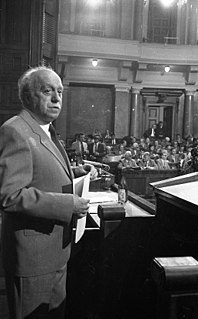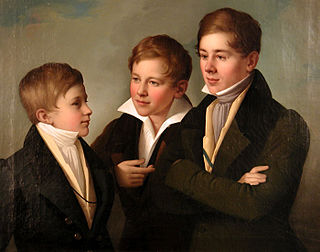The year 1899 in art involved some significant events.

Tomaž Šalamun was a Slovenian poet who was a leading figure of postwar neo-avant-garde poetry in Central Europe and internationally acclaimed absurdist. His books of Slovene poetry have been translated into twenty-one languages, with nine of his thirty-nine books of poetry published in English. His work has been called a poetic bridge between old European roots and America. Šalamun was a member of the Slovenian Academy of Sciences and Arts. He lived in Ljubljana, Slovenia, and was married to the painter Metka Krašovec.
Vovk is a surname of Ukrainian origin that means wolf. It currently predominates among East and South Slavs in Ukraine, Belarus, Slovenia, and Croatia. Notable people with the surname include:
Among the modes of expression of the culture of Slovenia, a nation state in Central Europe, are music and dance, literature, visual arts, film and theatre. A number of festivals take place, showcasing music and literature.

Danilo Lokar was a Slovene physician and Expressionist writer.

Mitja Ribičič was a Slovene Communist official and Yugoslav politician. He was the only Slovenian prime minister of the Socialist Federal Republic of Yugoslavia (1969–1971).

Rakitna is a village and tourist resort in the Municipality of Brezovica in central Slovenia. The municipality is part of the traditional region of Inner Carniola and is now included in the Central Slovenia Statistical Region. Rakitna includes the hamlets of Na Klancu, Hudi Konec, Hrib, Boršt, Nakličev Konec, Podgora, Jezero, Novaki, Žobov Grič, Pri Cajzli, and Zakotkar.
Matjaž Schmidt was a Slovene artist and illustrator, best known for his children's books illustrations and comic strips.
Jelka Reichman is a Slovene painter and illustrator, best known for her children's books illustrations.

Marija Lucija Stupica was a Slovene children's book illustrator.
Milko Bambič also known by the nicknames Cvetanov and Banetov, was a prolific illustrator, cartoonist, caricaturist, inventor, children's writer, publicist, and painter from the Slovene minority in Italy (1920-1947). He is regarded as one of the most versatile Slovene artists and a prominent Italian Futurist painter. He published in both Italian and Slovene. He is known for the first Slovene comic strip Little Negro Bu-ci-bu, an allegory of Mussolini's career, and as the creator of the Three Hearts brand, still used today by Radenska.
Alenka Sottler is a Slovene painter and illustrator. She lives and works in Ljubljana as a freelance illustrator and is a member of New York Society of Illustrators. She has illustrated over 50 books for children and adults, for which she received numerous awards and honours including her second nomination for the Hans Christian Andersen Award in 2014.
Suzana Bricelj is a Slovene painter and illustrator. Her illustrations appear in children's picture books, journals and magazines for young readers and even school books.
Zvonko Čoh is a Slovene painter, illustrator, and animator, best known as the co-author of the first Slovene animated feature length film. He has illustrated over thirty books for children and teenagers and made over twenty short animated films.
Jelka Godec Schmidt is a Slovene illustrator and writer of children's books.
Janez Vidic was a Slovene painter and illustrator, best known for his oil paintings of landscapes and people as well as his murals.

Art of Slovenia refers to all forms of visual art in or associated with Slovenia, both before and after the country's Independence from Yugoslavia in 1991. Art in Slovenia has been shaped by a number of Slovenian painters, sculptors, architects, photographers, graphics artists, comics, illustration, and conceptual artists. The most prestigious institutions exhibiting works of Slovene visual artists are the National Gallery of Slovenia and the Museum of Modern Art in Ljubljana.
Slovene minority in Italy, also known as Slovenes in Italy is the name given to Italian citizens who belong to the autochthonous Slovene ethnic and linguistic minority living in the Italian autonomous region of Friuli – Venezia Giulia. The vast majority of members of the Slovene ethnic minority live in the Provinces of Trieste, Gorizia, and Udine. Estimates of their number vary significantly; the official figures show 52,194 Slovenian speakers in Friuli-Venezia Giulia, as per the 1971 Census, but Slovenian estimates speak of 83,000 to 100,000 people.
This page is based on this
Wikipedia article Text is available under the
CC BY-SA 4.0 license; additional terms may apply.
Images, videos and audio are available under their respective licenses.





